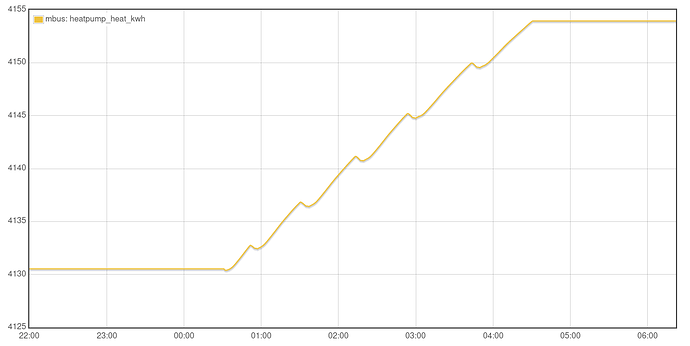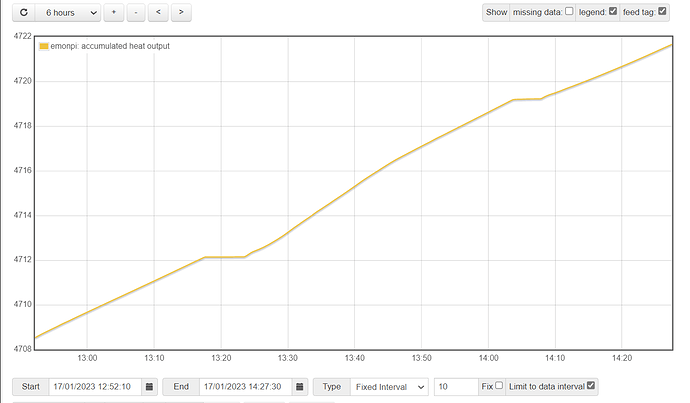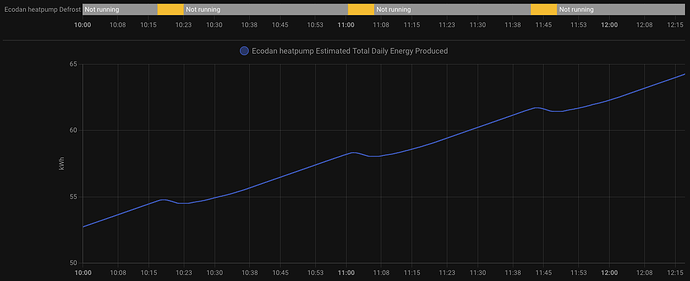sorry if this has been covered before. looking at various heatpumps on heatpumpmonitor.org it would seem standard that heat meters only work in one direction - i.e measure heat going into the house - however when defrosting the heatpump - heat is taken out of the heating circuit as shown by the flow/return temps crossing. Is this leading to artificially high COP readings during defrost? just puzzles me a bit. typically during a defrost there will be a period where the flow temp is actually lower than the return temp - whilst the heatpump uses the heat from the water to melt the ice on the evaporator coil. This heat is then replaced by the heatpump when it restarts in normal heating after the defrost - but if the heat extracted is not accounted for then surely the COP is overstated. If the heat measure could go negative and the heatpump app deal with negative values (i.e heat leaving the building) then it would seem more correct to me.
Might have answered my own question - looking at the detail view on the heatpump app it looks like it does measure negative values - since the range can go negative - but it is not displayed on the graph - so maybe the calculation underlying is correct??
A good question. Most heat meters are configured for heating only and while they output heat power as a positive or negative (cooling) value their energy register usually only accumulates the heating component. It is possible to calculate a heating and cooling cumulative energy value by using the ‘power to kWh’ input processor in emoncms which is what I do for my heat pump monitoring (here’s my dashboard Emoncms - app view dashboard). So the COP on my system does include the heat lost due to defrosts.
The My heat pump app does not show values below zero for a clearer display, but it does calculate the COP value in the window based on taking into account positive and negative heat.
This is something that would be good to have a standard approach to on heatpumpmonitor.org as I imagine there’s a bit of a mix of systems taking this into account and others not.
If we look at the best performing system on the list: https://emoncms.org/ecodantest2/app/view?name=My+Heatpump. The feed used to provide the cumulative heat output in kWh can be viewed directly here: Emoncms - graph 451963 zooming in on last night with several defrosts we can see that total delivered heat reduces slightly at each defrost:
Thanks Trystan, that’s very clear.
I don’t have a heat meter - I am using a carefully calibrated delta T multiplied by a magic number that represents both flow rate and heat capacity of the glycol/water mix - in my system I believe the flow rate is reasonably constant as I have a low loss header and run the system open with TRVs fully open and primary and secondary flow temps are within 0.5 DegC of each other - I also calibrated by running off a fixed volume of DHW and measuring power to reheat back to starting temp - not ideal but its what I’ve got for now.
For comparison purposes it would be good to know that some kind of calibration is used in all cases where we are comparing systems but probably not realistic in practice.
I will change my heat calculation to include negative values of DT - at the moment it is clamped to positive values only.
I was wondering about frigging the divertor valve on the system so that it thinks it is doing heating whilst in fact it is heating DHW - it would then be possible to draw of a known flow rate of DHW at a known temperature and calculate a constant heat load against which the heat meter could be checked - I guess a wear cup would give a pretty accurate flow measure - and it would be easy to check with a stop watch and a measuring jug.
Not got round to trying it yet - and to be honest I am warm and running costs seem sensible so I overall happy.
here is my accumulated heat graph - as you can see the heat output does not go negative during defrost - I will change that.
I have an Ecodan with a MMSP compliant and calibrated heat meter provided by the manufacturer. Looking at the minute-by-minute energy report downloaded from MELCloud I can confirm that it does indeed only count up and never reports negative energy.
However, for RHI payments, OFGEM take the defrosts into account by deducting 3% from the measured heat output. Extract from “Domestic RHI: Guide to Metering”:
ASHPs which use a defrost coil that uses heat purely from the home (i.e., no additional
heat source besides that generated by the ASHP should contribute to the defrost coil
mechanism), a multiplier factor of 0.97 should be applied to the heat output figure.
So, if I wanted a more representative measure of performance for my system, I could use this same factor of 0.97, which drops my overall SCOP from 3.40 to 3.30 ![]() I don’t think my system is losing that much heat to defrosts.
I don’t think my system is losing that much heat to defrosts.
Not sure what the accuracy of these heat meters is - but 3% sounds like it would be likely within the measuring tolerance anyway.
Heat meters are first and foremost a fiscal device.
Contracts are concluded based on gross heating / gross cooling; so the cumulative registers for heat / cool can ONLY go up.
Likewise elecrticity meters. The cumulative registers for import / export can ONLY go up.
Heat meters with dual registers (heat / cool; not just heat) are available. We tend to use the Axioma E4 models - £175+VAT in DN25 size to suit heat pumps - on systems with pure water fill.
Even without defrost you will get some cooling on a heat pump setup. When the heat pump starts and the circulator kicks a slug of cool outdoor water into a warm house before the compressor and refrigerant mean the outdoor water is hotter than indoor water. When there’s a pump kick once every 24 hours and again the cool water is flushed into the warm house and pushes out warm water from the house. And when a cool heat pump initially starts to reheat a lukewarm hot water cylinder so draws from it. And also during defrost. This causes systemic over-metering of the net heat delivery into the property.
“0.97” might be right. It might also be wrong. You should always use heat/cooling meters if you’re metering. Usually the same price. To do otherwise is buying the wrong thing.
Axioma do them. Kamstrup do them. Sontex do them if you need a glycol capable meter.
19 posts were split to a new topic: How to reduce frequency of defrosts on Daikin Altherma?
Interesting discussion. I implemented a live daily meter for the ecodan (esp32) and output negative when defrosting. Also tried to estimate these, and it cost around 0,4kWh per defrost on my system. On bad days you can easily get 30 defrost and that adds up. When I compare my calculated totals with the numbers reported by the ecodan than it seems that the ecodan does not take the defrost into account in its daily total. If I correct the defrost amount, then the totals align pretty good.


